Click on images to enlarge
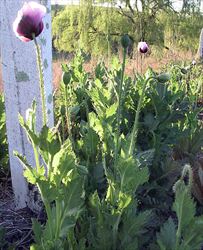
habit of Papaver somniferum subsp. setigerum in flower, with hairy stems (Photo: Jackie Miles and Max Campbell)

habit of Papaver somniferum subsp. somniferum in flower with hairless stems (Photo: Greg Jordan)

habit of Papaver somniferum subsp. setigerum prior to flowering (Photo: Sheldon Navie)
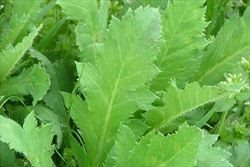
hairy lower leaves of Papaver somniferum subsp. setigerum (Photo: Sheldon Navie)
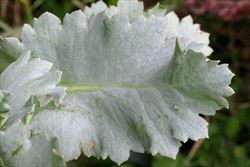
hairless leaf of Papaver somniferum subsp. somniferum (Photo: Trevor James)
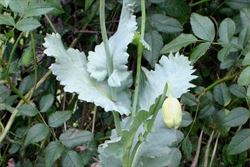
upper leaves and hairless stems of Papaver somniferum subsp. somniferum (Photo: Trevor James)
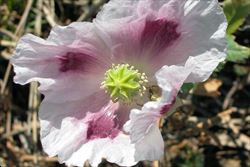
close-up of flower (Photo: Greg Jordan)

the large, almost rounded, fruit of Papaver somniferum subsp. somniferum (Photo: Trevor James)

close-up of seeds (Photo: Steve Hurst at USDA PLANTS Database)

young Papaver somniferum subsp. setigerum plant (Photo: Sheldon Navie)
Scientific Name
Papaver somniferum L.
Synonyms
Papaver album Mill.Papaver setigerum DC.Papaver somniferum L. subsp. setigerum (DC.) CorbPapaver somniferum L. subsp. somniferumPapaver somniferum L. var. setigerum (DC.) ElkanPapaver somniferum L. var. somniferum
Family
Papaveraceae
Common Names
oil poppy, oil seed poppy, opium poppy, poppy, small opium poppy, small-flower opium poppy, small-flowered opium poppy, wild poppy
Origin
Native to northern Africa (i.e. northern Algeria, northern Libya, Morocco and Tunisia), the Azores, the Madeira Islands, the Canary Islands, southern Europe (i.e. Greece, Italy, France, Portugal and Spain) and Cyprus.
Naturalised Distribution
Opium poppy (Papaver somniferum) is widely naturalised in southern Australia and is most common and widespread in New South Wales, the ACT, Victoria, Tasmania and south-eastern South Australia. It is also relatively common in south-western Western Australia and occasionally naturalised in southern Queensland, the southern parts of the Northern Territory and other parts of South Australia. Also naturalised on Lord Howe Island and Norfolk Island.
Note: Opium poppy (Papaver somniferum subsp. somniferum) and small-flowered opium poppy (Papaver somniferumsubsp. setigerum ) are recognised as separate entities in New South Wales, Queensland, Western Australia and Tasmania, but not elsewhere in Australia. Both sub-species are naturalised in New South Wales, Queensland and Tasmania, but only small-flowered opium poppy (Papaver somniferum subsp. setigerum) is thought to be present in Western Australia. In general, small-flowered opium poppy (Papaver somniferum subsp. setigerum) is more widespread and common than opium poppy (Papaver somniferum subsp. somniferum) in Australia. The two sub-species can be distinguished by the following differences:
- opium poppy (Papaver somniferum subsp. somniferum) has very few, if any, bristly hairs on its stems and leaves. Its fruit are relatively large (about 5 cm across) and almost rounded in shape (i.e. globose).
- small-flowered opium poppy (Papaver somniferum subsp. setigerum) has stems and leaves that are covered in bristly hairs. Its fruit are relatively small (about 2 cm across) and slightly elongated in shape (i.e. cylindrical or sub-globose).
In addition, cultivars of opium poppy (Papaver somniferum) with double flowers of a variety of colours are sometimes cultivated as garden ornamentals in Australia. These double-flowered plants are generally called peony poppies (Papaver somniferum var. paeoniflorum or Papaver paeoniflorum).
Notes
Opium poppy (Papaver somniferum) is regarded as an environmental weed in Victoria, the ACT and Tasmania. As well as being a weed of crops and disturbed sites, this species invades natural habitats. It is a regarded as a common environmental weed in north-western Tasmania and grows in herbfields and grasslands in Western Australia.
Opium poppy (Papaver somniferum) has also been recorded in conservation areas in Victoria (i.e. Barkindji Biosphere Reserve), South Australia (i.e. Belair National Park, Flinders Ranges National Park, Coffin Bay National Park and Innes National Park) and New South Wales (i.e. Langtree Nature Reserve and Cocoparra National Park).

